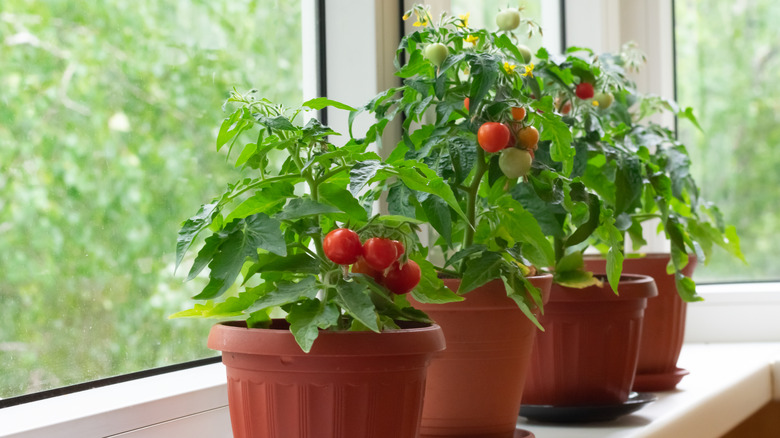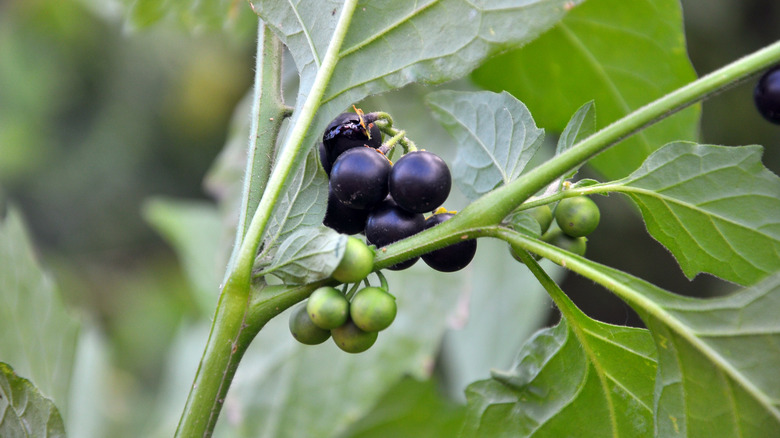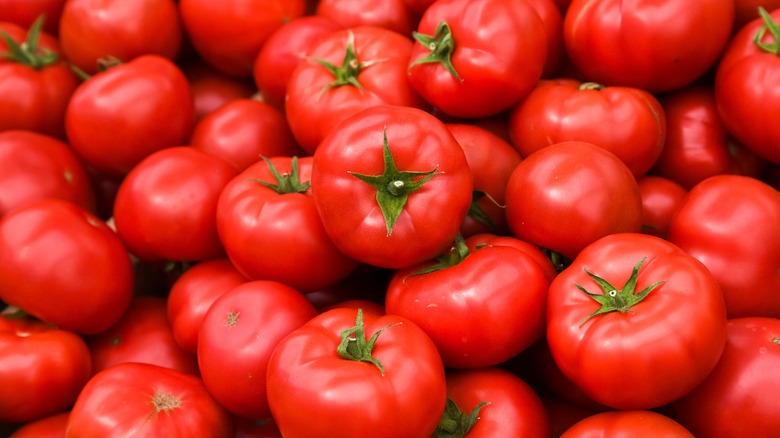The Odd Reason Why Tomatoes Used To Only Be Used As Decoration
Before the modern world started asking, "Is a tomato a fruit or a vegetable?" Europeans in the Age of Discovery were asking themselves, "Is a tomato even safe to eat?" The tomato (Solanum lycopersicum) belongs to the nightshade family (Solanaceae), which includes an Old World native — the deadly nightshade (Atropa belladonna) known as belladonna. The tomato, on the other hand, hails from the New World.
When the tomato first arrived in Europe during the 1500s, Europeans were unfamiliar with the crop. The best thing botanists had to compare it with was its relative, lethal belladonna. One specific botanist categorized it as an aphrodisiacal mandrake, giving it a salacious reputation. Others purported that it didn't even taste particularly good, a belief that thrived in Britain.
As a result, folks were reluctant to try a taste. Instead, they grew the flowery plant with its warmly colored "berries" in gardens for aesthetics. Meanwhile, some nobles who dared a bite of the "poison apple" truly did perish, but really, this was because the aristocrats used pewter plates full of poisonous lead, which was drawn out by tomatoes' acidity. The true culprit wasn't known, so unfortunately, tomatoes took the blame.
In fact, the leaves and roots of the tomato plant are indeed toxic. Eventually, though, the Italians and Spaniards figured out its berries are safe and delicious, cluing the rest of the continent to tomatoes' culinary potential — but it certainly took time getting there. Even in the late 18th century, many Europeans still feared it. This seems silly now, but there was historical context well worth considering.
Belladonna is an infamous killer
Whether you call it beautiful death, devil's berries, or naughty man's cherries, this relative of the tomato is not to be trifled with. The deadly nightshade's roots, flowers, leaves, and berries are all toxic enough to kill an individual. Even just a couple of its attractively glossy black berries can kill a child; a dozen does the same to an adult. Meanwhile, pets are prone to eating their leaves. Even nonlethal doses cause delirium, hallucinations, irregular heartbeat, respiratory problems, and vomiting.
Death by belladonna isn't always accidental. Assassins historically used the herb to poison their targets. Crafty ones even developed a tolerance to deadly nightshade by regularly drinking small amounts; that way, they could trick victims into consuming the sweet poison by first imbibing it themselves. Additionally, the Ancient Romans once coated their arrow tips with the toxin to make more effective weapons.
"Atropa" is a reference to the Greek Fates, which supposedly determined when a person's life would end. Oddly, "belladonna" translates to "beautiful woman" in Italian, hinting at the deadly nightshade's surprisingly lethal attributes. Venetian ladies would use the plant's oils to dilate their pupils, enlarging them because they liked the alluring look of it. Belladonna has also been utilized as anesthesia during surgery since low quantities produce sleepiness and numbness rather than death. Additionally, the plant is still employed in modern medicine as a chloroform antidote, eye-surgery aid, and pain-relief salve. It's a wonder that tomatoes became the more famous family member!
Indigenous Americans domesticated the tomato
Technically, it isn't entirely accurate to say tomatoes used to exclusively be grown for decorative purposes. The original tomato plant likely comes from South America's Andes Mountains of modern-day Ecuador and Peru; although, some believe tomatoes hail from Mexico. The manner in which tomatoes were domesticated during prehistory is a bit uncertain, but it's believed both of these areas were involved.
Thousands of years ago, wild tomatoes were only the size of blueberries. According to one long-standing theory, native South Americans bred tomatoes to increase in size — to about the size of a modern cherry tomato. Gradually, natural proliferation and trade brought those tomatoes north to Mesoamerica, where they were further bred to become even more voluminous. This was likely not a straightforward process, but rather an ongoing back-and-forth between North and South America.
Regardless, by the time the Columbian Exchange brought Spain's conquistadors to South America, the crop in question had been given the name "tomatl" by the Aztecs. Tomatl was a staple of their diet, and Aztec markets sold many varieties of tomatoes — small and large, red and yellow, some particularly leafy, others notably sweet. Still, European botanists were skeptical. In fact, they even thought its origin point meant that tomatoes should ideally be consumed in warmer climates. Nevertheless, Indigenous Americans knew the value of the food they had grown, and so, tomatoes eventually spread across the globe.


